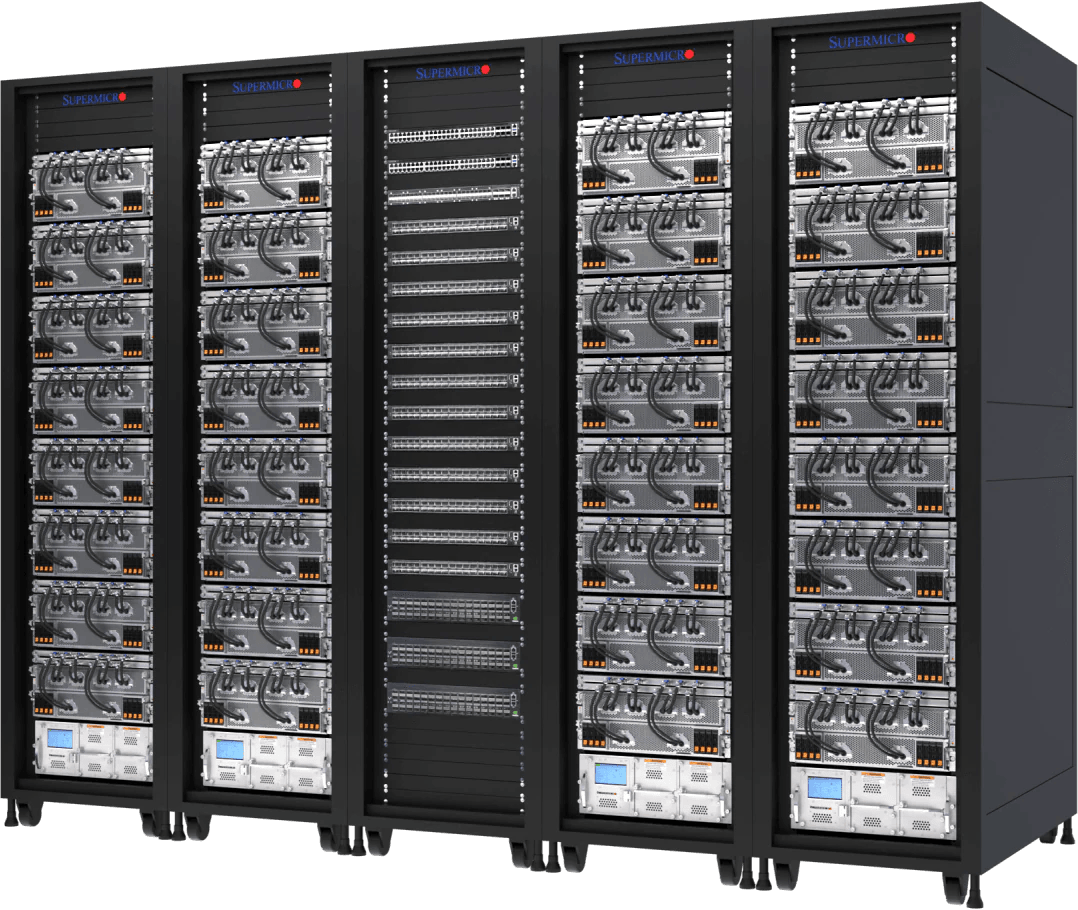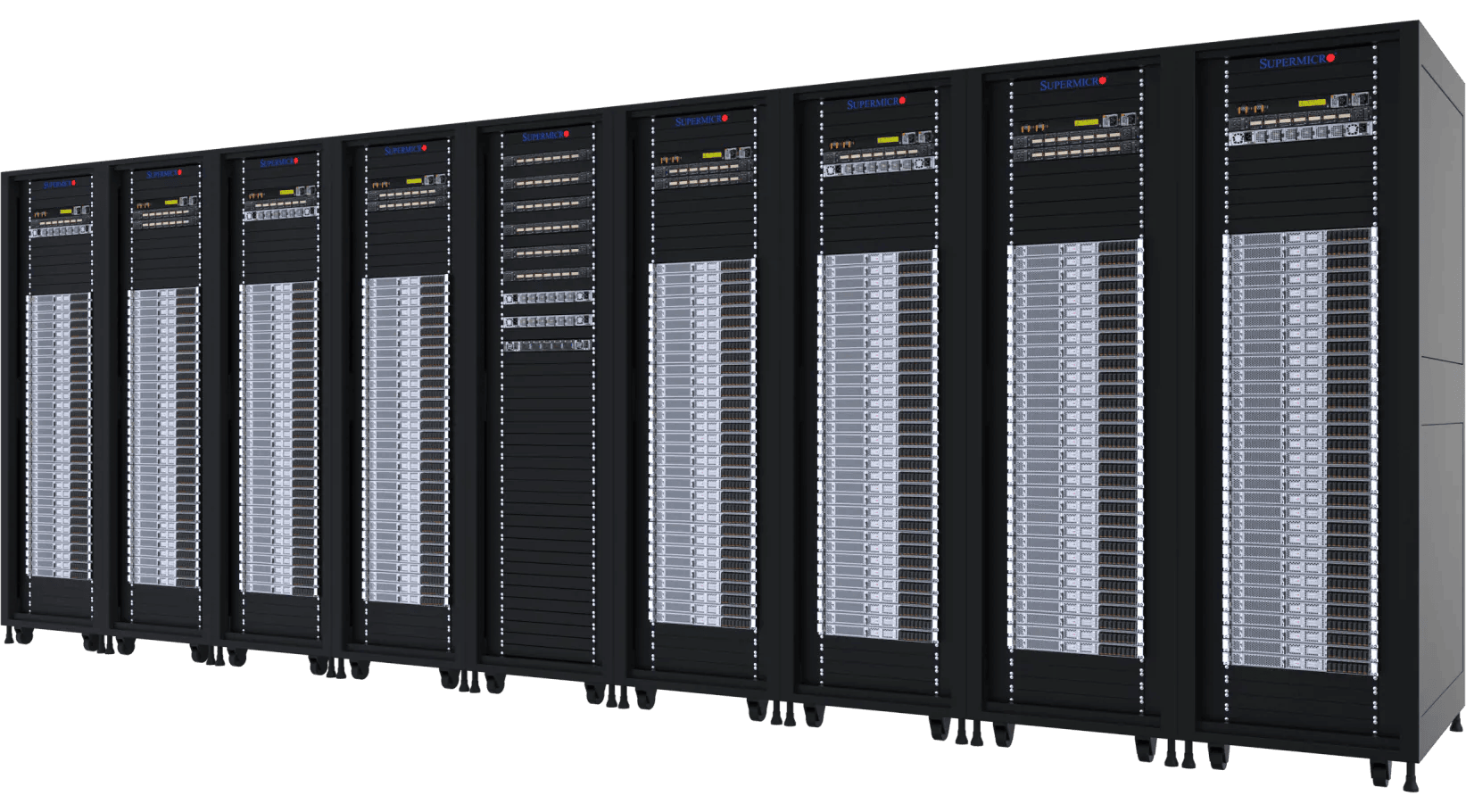Solutions for Generative AI
Supermicro SuperCluster Solutions
Supermicro's SuperCluster Solutions offer advanced, scalable infrastructure for generative AI, ideal for training large language models (LLMs) and cloud-scale inference. Below you can find the key features.
- High-Performance GPUs: Integration of NVIDIA H100/H200 Tensor Core GPUs ensures exceptional performance for AI tasks, supporting up to 512 GPUs in liquid-cooled and 256 GPUs in air-cooled setups
- Advanced Cooling and Networking: Features liquid cooling and high-speed network fabrics like 400G InfiniBand and 400GbE Ethernet, ensuring optimal performance and low latency
- Comprehensive Software: Includes NVIDIA AI Enterprise for streamlined AI model deployment and management
- Scalability: Expandable from 32 nodes to thousands, tailored to meet specific AI requirements
- Turnkey Solutions: Plug-and-play units for rapid deployment, minimizing setup time and accelerating results

Highest compute density
With 32 NVIDIA HGX H100/H200 8-GPU, 4U Liquid-cooled Systems (256 GPUs) in 5 Racks
- Doubling compute density through Supermicro’s custom liquid-cooling solution with up to 40% reduction in electricity cost for data center
- 256 NVIDIA H100/H200 GPUs in one scalable unit
20TB of HBM3 with H100 or 36TB of HBM3e with H200 in one scalable unit - 1:1 networking to each GPU to enable NVIDIA GPUDirect RDMA and Storage for training large language model with up to trillions of parameters
- Customizable AI data pipeline storage fabric with industry leading parallel file system options
- NVIDIA AI Enterprise Software Ready

Proven design
With 32 NVIDIA HGX H100/H200 8-GPU, 8U Air-cooled Systems (256 GPUs) in 9 Racks
- Proven industry leading architecture for large scale AI infrastructure deployments
- 256 NVIDIA H100/H200 GPUs in one scalable unit
- 20TB of HBM3 with H100 or 36TB of HBM3e with H200 in one scalable unit
- 1:1 networking to each GPU to enable NVIDIA GPUDirect RDMA and Storage for training large language model with up to trillions of parameters
- Customizable AI data pipeline storage fabric with industry leading parallel file system options
- NVIDIA AI Enterprise Software Ready

Cloud-Scale Inference
With 256 NVIDIA GH200 Grace Hopper Superchips, 1U MGX Systems in 9 Racks
- Unified GPU and CPU memory for cloud-scale high volume, low-latency, and high batch size inference
- 1U Air-cooled NVIDIA MGX Systems in 9 Racks, 256 NVIDIA GH200 Grace Hopper Superchips in one scalable unit
- Up to 144GB of HBM3e + 480GB of LPDDR5X, enough capacity to fit a 70B+ parameter model in one node
- 400Gb/s InfiniBand or Ethernet non-blocking networking connected to spine-leaf network fabric
- Customizable AI data pipeline storage fabric with industry leading parallel file system options
- NVIDIA AI Enterprise software ready
Foundational Building Blocks for Generative AI Infrastructure
In the era of AI, a unit of compute is no longer measured by just the number of servers. Interconnected GPUs, CPUs, memory, storage, and these resources across multiple nodes in racks construct today's artificial Intelligence. The infrastructure requires high-speed and low-latency network fabrics, and carefully designed cooling technologies and power delivery to sustain optimal performance and efficiency for each data center environment. Supermicro’s SuperCluster solution provides foundational building blocks for rapidly evolving Generative AI and Large Language Models (LLMs).
Complete Integration at Scale
Design and build of full racks and clusters with a global manufacturing capacity of up to 5,000 racks per month
Test, Validate, Deploy with On-site Service
Proven L11, L12 testing processes thoroughly validate the operational effectiveness and efficiency before shipping
Liquid Cooling/Air Cooling
Fully integrated liquid-cooling or air cooling solution with GPU & CPU cold plates, Cooling Distribution Units and Manifolds
Supply and Inventory Management
One-stop-shop to deliver fully integrated racks fast and on-time to reduce time-to-solution for rapid deployment




Schrijf in voor onze Nieuwsbrief
Hebt u vragen of hulp nodig? Wij helpen u graag.
